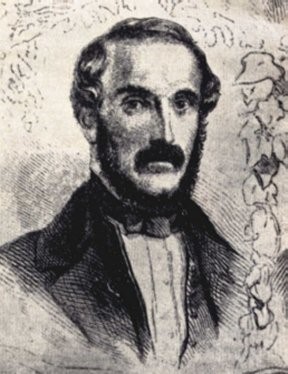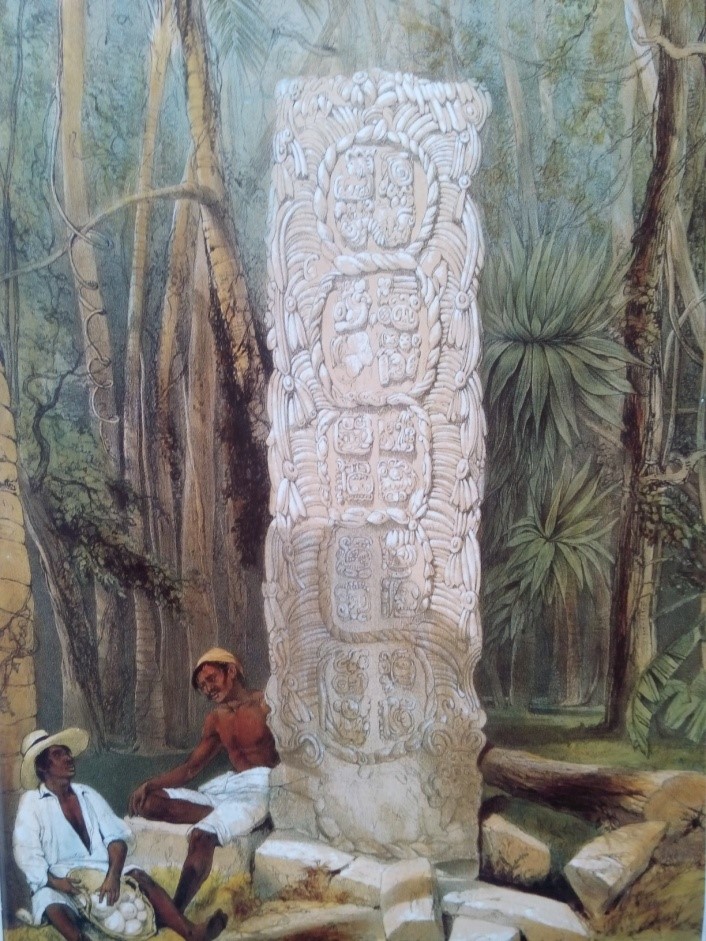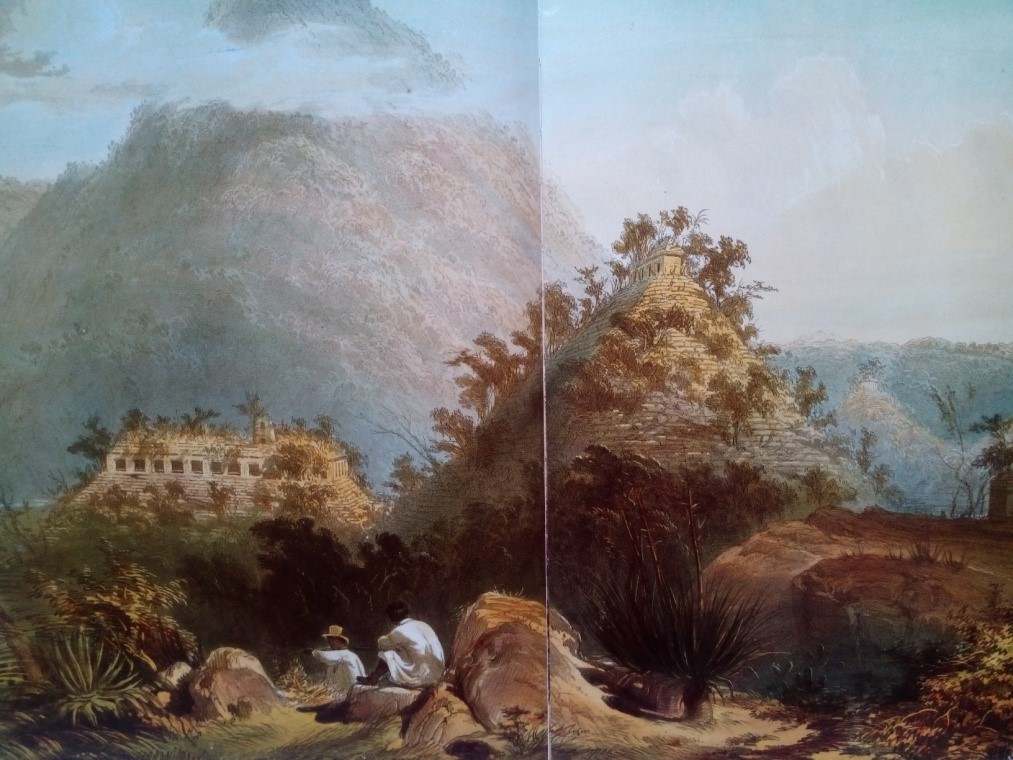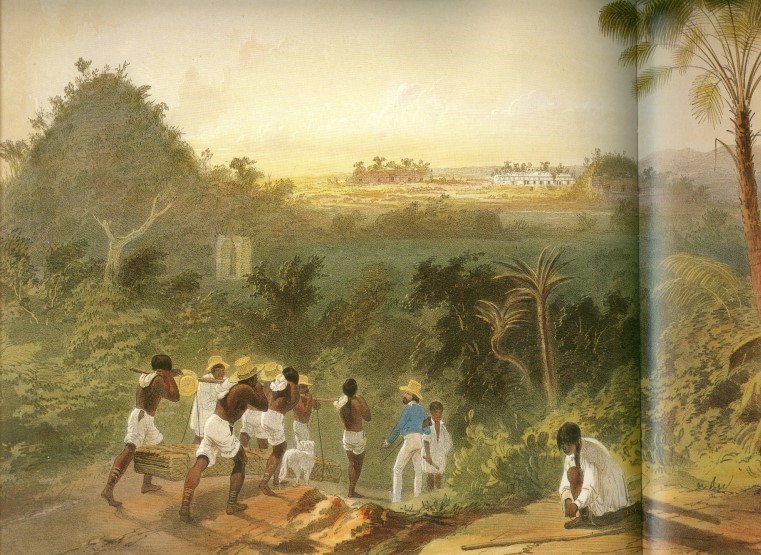John Lloyd Stephens
by Gesa Mackenthun, 03/01/2016.
Summary
John Lloyd Stephens was a New York lawyer sent traveling by his physician to cure a throat infection. As a result, he became one of America’s most fascinating travel writers. While in London, he teamed up with the British painter Frederick Catherwood, and they subsequently traveled the states of Central America in the late 1830s and early 1840s in search of adventure and ancient Maya ruins. Stephens’s travelogues and Catherwood’s lithographs are some of the most valuable documents of early archaeology. At the same time, however, Stephens also regarded his scientific work as an extension of his political aims, which agreed with the expansionist ideology of the United States. He was almost successful in acquiring ruined cities by purchase and he did succeed in transporting monuments and artifacts to the United States to be exhibited there for the American public. Stephens’s archaeological exploits must be seen in the contexts of the growing entertainment industry and of the imperial archaeology of his age – with all Western nations competing with each other to fill their metropolitan museums with the monuments and artifacts of ancient sites outside their own territories. This was the rosy dawn of modern world heritage practice.


In the year 1840, the American traveler John Lloyd Stephens (Fig. 1) and his British companion, the painter Frederick Catherwood, traveled throughout Central America in search of hidden Maya ruins. Having reached the ancient ruined city of Copán, in today’s Honduras, a new plan ripened in Stephens’s mind: “To buy Copán!”
For many weeks had the two adventurers employed local helpers to free the ancient ruins from shrubs and trees in order to measure the sites and make drawings of the buildings and ornaments. But now Stephens had reached a point where painful scientific documentation was not enough anymore. He dreamt of turning the monuments into commodities and speculation objects: “Hide your heads, ye speculators in up-town lots!”[1] His idea was to “remove the monuments of a by-gone people from the desolate region in which they were buried, set them up in the ‘great commercial emporium’, and found an institution to be the nucleus of a great national museum of American antiquities!”[2] Stephens offered fifty dollars to the owner of the ground on which Copán stood, and since he also traveled the land as an official diplomatic envoy of the United States, he unpacked his official documents and his diplomatic coat with the eagle buttons to impress the local villagers who had to think that the transaction was an official diplomatic act.[3] As soon as the purchase was completed, Stephens and Catherwood began documenting the monuments of Copán – floor plans and drawings of the ornamental steles. In his text, Stephens dreams of using the monuments from Copán to rival the imperial museums of Europe: “The casts of the Parthenon,” he writes, “are regarded as precious memorials in the British Museum, and casts of Copán would be the same in New-York.” After all, he concludes, “They belonged of right to us.”[4] He reinforces this claim of possession at the end of his second volume when he admonishes the nations of the Old World to “respect the rights of nations and discovery, and leave the field of American antiquities to us; […]not [to] deprive a destitute country of its only chance of contributing to the cause of science, but rather encourage it in the work of bringing together, from remote and almost inaccessible places, and retaining on its own soil, the architectural remains of its aboriginal inhabitants.”[5]
Archaeology and Politics
Stephens wrote his travelogue at the height of American westward expansion: in the decade before he left for Central America, the US government had carried out its infamous deportation of Native Americans from their homelands east of the Mississippi to the Indian Territory in today’s Oklahoma. The mass removal had culminated in the Trail of Tears in 1838 during which thousands of people died. The concurrence of these events with Stephens’s archaeological ‘mission’, in addition to his use of his political function for purchasing the ruins, suggests an ideological link between the archaeological advance into areas south of the United States and the military advances of continental conquest. The continentalist perspective becomes manifest in Stephens’s loose employment of possessive pronouns in the above quote: the indigenous inhabitants of Mesoamerica were “its [i.e. the United States’] aboriginal inhabitants” only in Stephens’s own construction of America’s prehistorical migrations: as many contemporaries, he assumed that the original inhabitants had consistently moved through the hemisphere from North to South. (But such a narrative, one should assume, hardly justified claims to territories and artifacts in areas outside the United States.) Only eight years after the events at Copán, the U.S. Army would actually invade Mexico City; the Mexican-American War, which was a reaction to the American acquisition of Texas in 1845, ended with Mexico ceding large territories to the victorious United States (including today’s California).
Although John Lloyd Stephens’s travelogue has justly received praise for its literary qualities, and Catherwood’s artistically superb drawings (Fig. 3), because of their documentary precision, were helpful in deciphering the Maya script in the twentieth century, the archaeological venture into the territory of the ancient Maya was clearly understood as part of a larger scheme of cultural appropriation, after the model of European imperial nations. Tripp Evans has referred to Stephens’s project as an archaeological Monroe doctrine – based on Stephens’s emphasis that ancient American cultures developed in complete isolation from the cultures of European antiquity and his strong continentalist design.[6]
A Man of many Trades
Stephens did succeed in transporting artifacts to New York but unfortunately most of them were destroyed in a fire. Although not a trained archaeologist (that science was still in its infant shoes in the 1840s), Stephens and Catherwood have left us with an important documentation of the condition of the pre-Columbian monuments in Mexico, Central America and Yucatán that should not be underestimated. Stephens’s “museum of American antiquities” became the Smithsonian Institution, founded in 1846. Their travel reports and illustrations are masterpieces of romantic travel literature and visual aesthetics and have remained in print since their first publication.
Apart from his skills as an amateur scientist and writer, Stephens also showed engineering expertise: He considered the building of a canal through Nicaragua (pretty much along the route now surveyed by the Chinese investors for an environmentally disastrous Nicaragua canal). When he recognized that the technical possibilities of his time were insufficient for realizing this project, he engineered the first railroad line across Panama, part of which was completed before Stephens died in 1852.
One of the first Germans to take that train route on the way to Gold Rush California was Heinrich Schliemann who traveled to Sacramento to claim the inheritance of his deceased brother. As Stephens’s biographer Victor Wolfgang von Hagen writes, the meeting between Stephens and the “small nervous German merchant” must have been a curious encounter.[7] After his return to Europe Schliemann used the money gained in California, as well as the gains from financial speculation in the slave-based Atlantic economy in the 1850s and 1860s, to finance his later archaeological digs in search of Troy and Priam’s treasure.
Von Hagen’s meeting is scientific romance. The two amateur archaeologists never met in person. A one hour meeting between Stephens and aged Alexander von Humboldt in 1847, however, really took place. The cosmopolitan Humboldt and the imperialist Stephens, it seems, had a nice chat in Humboldt’s Potsdam residence, discussing archaeology, technological improvements, and military tactics.[8]
NOTES
[1] Stephens, Incidents of Travel in Central America, Chiapas and Yucatan, Vol. 1: 115.
[2] Loc. Cit.
[3] Ibid., 127.
[4] Ibid., 115.
[5] Ibid., vol. 2: 474.
[6] Evans, Romancing the Maya 55-58.
[7] Von Hagen, Maya Explorer 295-96.
[8] See Mackenthun, “Imperial Archaeology.”
LITERATURE
Evans, R. Tripp. Romancing the Maya: Mexican Antiquity in the American Imagination 1820-1915, Austin: University of Texas Press, 2004.
Mackenthun, Gesa. “Imperial Archaeology: The American Isthmus as Contested Scientific Contact Zone.” Surveying the American Tropics. Literary Geographies from New York to Rio. Ed. Maria Cristina Fumagalli, Peter Hulme, Owen Robinson, Lesley Wylie. Liverpool University Press, 2013. 101-130.
Stephens, John Lloyd. Incidents of Travel in Central America, Chiapas and Yucatan. [1841], 2 vols., New York: Dover, 1969.
Von Hagen, Victor Wolfgang. Maya Explorer. John Lloyd Stephens and the Lost Cities of Central America and Yucatán. Norman: University of Oklahoma Press, 1947.
FURTHER READING
Glassman, Steve. On the Trail of the Maya Explorer, Tuscaloosa: University of Alabama Press, 2003.
Harvey, Bruce A. American Geographics: US National Narratives and the Representation of the Non-European World, 1830-1865, Stanford: Stanford University Press, 2001.
Mackenthun, Gesa. “The Conquest of Antiquity: The Travelling Empire of John Lloyd Stephens.” American Travel and Empire. Ed.Susan Castillo and David Seed. Liverpool: Liverpool University Press, 2009. 99-128.
ILLUSTRATIONS
Figure 1: Source: Victor Wolfgang von Hagen, Maya Explorer. John Lloyd Stephens and the Lost Cities of Central America and Yucatán. Norman: University of Oklahoma Press, 1947 (from Harper’s Monthly Magazine, January 1859).
Figure 2: Source: Fabio Bourbon, The Lost Cities of the Mayas. The life, art, and discoveries of Frederick Catherwood. New York/London: Abbeville Press, 2000.
Figure 3: Source: Fabio Bourbon, The Lost Cities of the Mayas. The life, art, and discoveries of Frederick Catherwood. New York/London: Abbeville Press, 2000.
Figure 4: Source: Fabio Bourbon, The Lost Cities of the Mayas. The life, art, and discoveries of Frederick Catherwood. New York/London: Abbeville Press, 2000.


